Short- And Long-Duration Energy Storage Essential To The Clean Energy Transition
The adoption of renewable energy is accelerating globally, particularly wind and solar power, as governments and corporations work towards meeting climate change-related emissions reduction targets and boosting energy security. The International Energy Agency (IEA) forecasts renewables capacity growth will be 50% higher from 2021–2026 than in 2015–2020.1 Despite this strong outlook, even faster renewable energy development will be required to reach global net-zero emissions by mid-century and keep global warming under 1.5˚C by 2100.2 In our view, the widespread adoption of energy storage systems is key to reaching the high levels of renewable energy generation required to reduce emissions within the power sector.
In this report, we explore how the global proliferation of renewable energy can drive rapid growth in energy storage over the coming years, with both short- and long-duration energy storage systems essential to the green energy transition.
Key Takeaways
- Energy storage capacity and generation are set to grow rapidly over the coming years, driven by the global proliferation of renewable energy, grid supply challenges, government support, and lower technology prices.
- We expect the rapid adoption of short-duration battery energy storage systems to create investment opportunities across the renewables and battery value chains, including renewables developers, storage system manufacturers, and miners of critical minerals.
- Growing government support for long-duration energy storage systems could support power grids while accelerating wind, solar, and hydrogen power development significantly. To reach net-zero power sector targets, the growth of these systems could represent a $1.5–3.0 trillion investment opportunity.3
A Successful Clean Energy Transition Requires Energy Storage Solutions
In 2021, renewable energy generation capacity grew by 9.1% to just under 3,065 gigawatts (GW).4 Globally, renewables accounted for 81% of all new capacity additions last year, driven by the wind and solar power sectors.5 We expect robust renewables growth to continue, with forecasts for capacity to reach 4,800GW by 2026.6 For context, 4,800GW is roughly equivalent to global fossil fuel and nuclear power capacity combined.7 In total, renewables are forecasted to account for 95% of all power capacity growth between 2022 and 2026.8
The robust growth outlook for renewable energy is due to several factors. Many governments are ramping up climate change mitigation efforts, including support for renewable energy adoption through tax credits, subsidies, and renewable project tenders and auctions. In the U.S., President Biden set a target for reaching a carbon pollution-free power sector by 2035.9 Also, corporations are seeking their own renewable energy supply to meet sustainability targets. In 2021, corporations procured 31.1GW of renewable energy globally via power purchase agreements (PPAs).10 The top three corporate clean energy buyers last year were Amazon, Microsoft, and Meta.11
In addition, technological advancements, including wind turbines and solar modules, make wind and solar power increasingly cost-competitive with traditional power sources while boosting overall performance and efficiencies. Critically, energy storage system technologies are also improving and becoming more cost-competitive due to falling battery costs and increased government support in many countries, including the U.S. and China.12 Global energy storage is forecast to explode from 17GW/34-gigawatt hour (GWh) in 2020 to 358GW/1,028GWh in 2030, according to BloombergNEF.13 The U.S. and China appear set to be the largest energy storage markets, with India, Australia, Germany, Japan, and the U.K. also expected to see strong growth.14
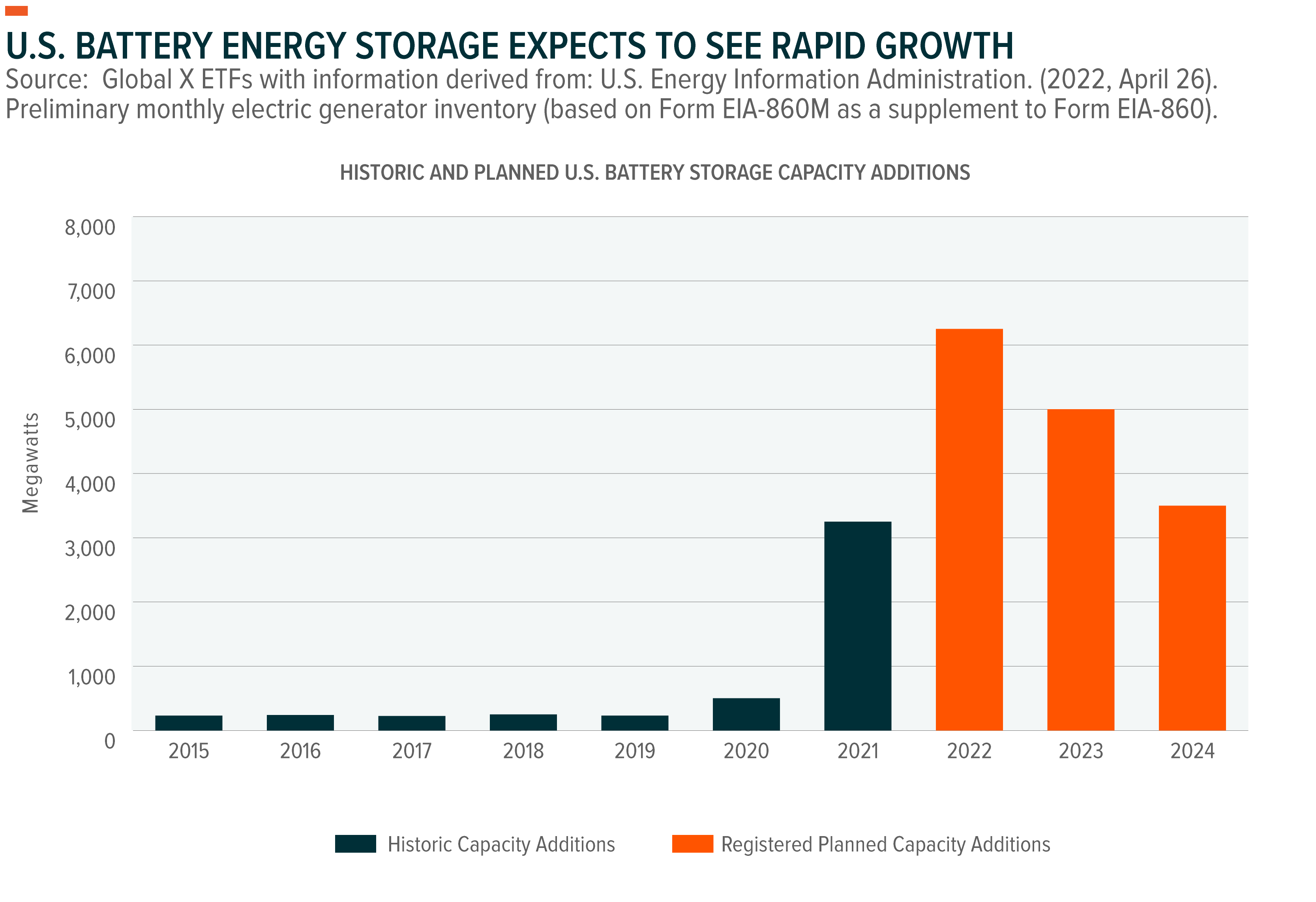
The energy storage landscape includes short- and long-duration energy storage solutions. Short-duration energy storage (SDES), also known as short-term energy storage, is defined as any storage system that is able to discharge energy for up to 10 hours at its rated power output. Long-duration energy storage (LDES) is any system that is able to discharge energy at its rated power output for 10 or more hours.15 We expect both types of storage will be necessary to balance increasingly renewable power grids on hourly, daily, weekly, and even seasonal timescales.
In our view, the widespread adoption of energy storage systems is essential for renewable energy to comprise high shares of the global power system, and the growing deployment of energy storage has the potential to accelerate wind and solar power growth. As intermittent power sources, wind and solar energy production often do not align with peak energy demand.16 The variability creates challenges for governments facing growing grid supply challenges, particularly amid increasing risks of extreme weather events that disrupt electricity production.17 In the U.S., the power crisis in Texas due to extremely cold temperatures in February 2021 and the risk of blackouts in California due to the prevalence of wildfires are two examples that highlight the importance of adopting grid-stabilizing technologies. Renewable energy paired with energy storage systems offers a potential solution.18
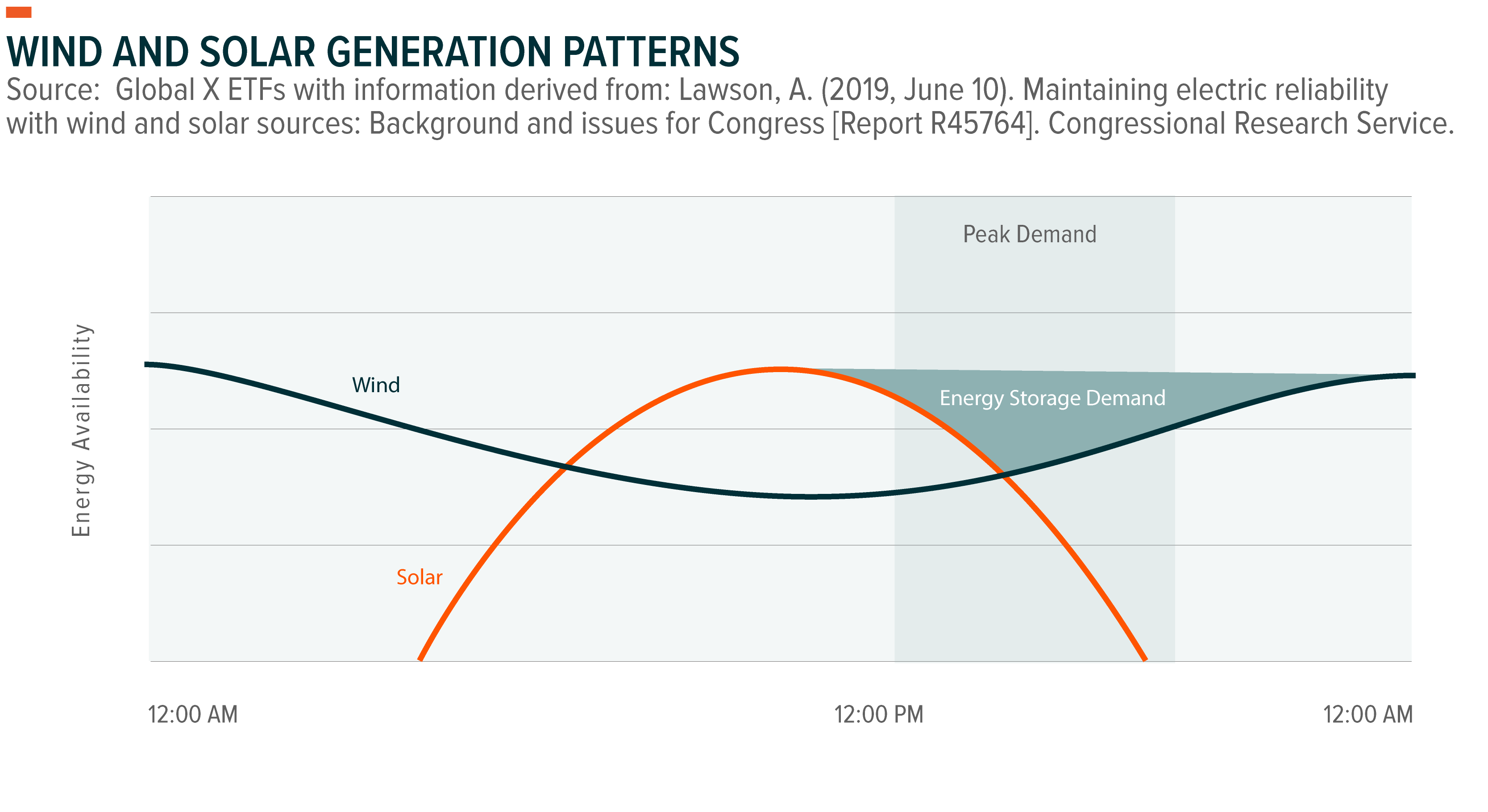
Growth in Battery Energy Storage Encompasses the Renewables and Battery Supply Chains
The growing BESS market creates opportunities for renewables project developers. Leading renewables developers such as NextEra Energy Resources, Enel Green Power, AES Corp, and Vistra Corp. are rapidly expanding their battery energy storage project pipelines.25 Notable operational projects include the 409MW/900-megawatt hour (MWh) Manatee Energy Storage Center from Florida Power & Light, a regulated utility of NextEra, and the 400MW/1,600MWh Moss Landing Energy Storage Facility by Vistra in California. The two projects are among the largest BESS in the world.26 Vistra plans to expand Moss Landing with an additional 350MW/1,400MWh battery system.27
Renewable developers could find additional wind and solar development opportunities as energy storage scales, with energy storage being a potential solution for insufficient and congested transmission and distribution infrastructure.28 Notably, energy storage systems offer several potential benefits including enhancing grid reliability, deferring transmission upgrades, and relieving transmission congestion.29,30 A lack of transmission or congested lines is a primary barrier to widespread renewables development in many countries, including the U.S. and Chile.31,32
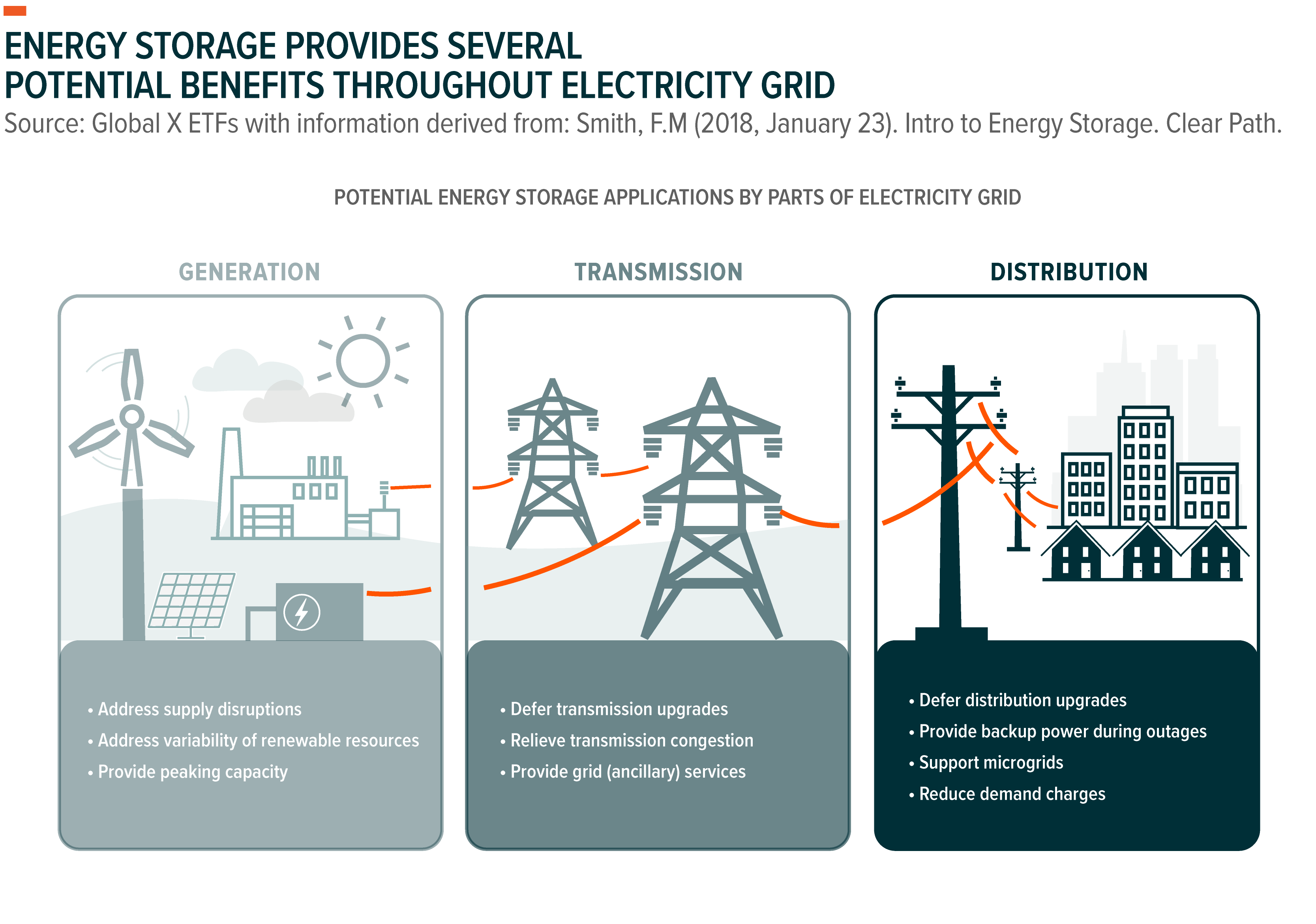
As a result, renewable energy developers are increasingly pairing wind and solar projects with BESS projects to create hybrid power systems. Of the 14.5GW of battery storage capacity registered as of year-end 2020 to come online in the U.S. through 2024, 63% are set to be co-located with solar power projects and an additional 9% with wind power projects.33 Hybrid renewables plus storage projects have the potential to reduce upfront transmission upgrade and interconnection costs, reduce how much electricity production is curtailed in times of oversupply, and expand the time window in which a project can send electricity to the grid.34
The rapid uptake of BESS can also create opportunities across the battery energy storage supply chain. Leading battery energy storage system manufacturers, including Tesla and Fluence Energy, a joint venture between Siemens and AES Company, reported strong demand through Q1 2022.35,36 Fluence Energy added 600MW in energy storage project orders, a 525% increase compared to Q1 2021.37 Energy storage growth could also increase demand for miners of lithium and other critical minerals, including copper, cobalt, nickel, and rare earth elements. Depending on the rate of growth in clean energy technologies such as electric vehicles and energy storage, lithium demand could be 13–43 times higher in 2040 than in 2020. Cobalt and nickel demand could be around 6–20 times higher.38
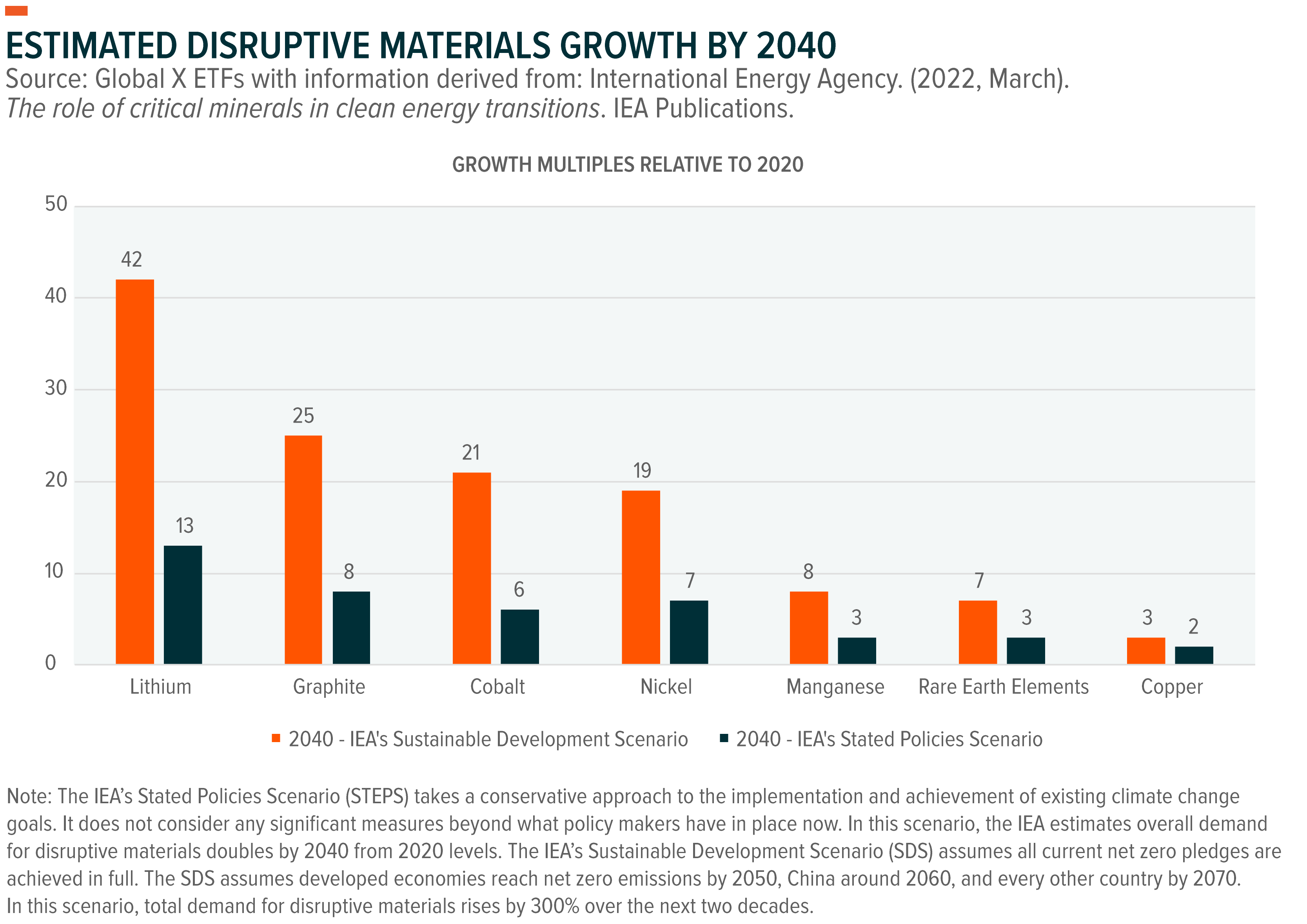
Development of LDES Systems Has Newfound Momentum
Long-duration energy storage systems offer stable energy output ranging from 10 hours to days, weeks, and even seasons, providing enhanced grid reliability compared to short-duration energy storage systems.39 LDES systems have been around for decades, most notably in the form of pumped storage hydropower systems. However, cost, permitting, and technological barriers, in addition to a lack of regulatory support, prevented LDES systems from widescale adoption.40,41
We expect that to change, though, as significant growth opportunities for LDES technologies emerge. To reach a global net-zero power sector targets, LDES must be scaled up by an estimated 400 times from present-day levels to 85–140TWh by 2040.42 This scale-up equates to a $1.5–3.0 trillion investment opportunity.43 Government interest in LDES systems is growing, including in the U.S. In July 2021, the U.S. Department of Energy announced an initiative called the Long Duration Storage Shot, which seeks to reduce costs for LDES by 90% by 2030.44
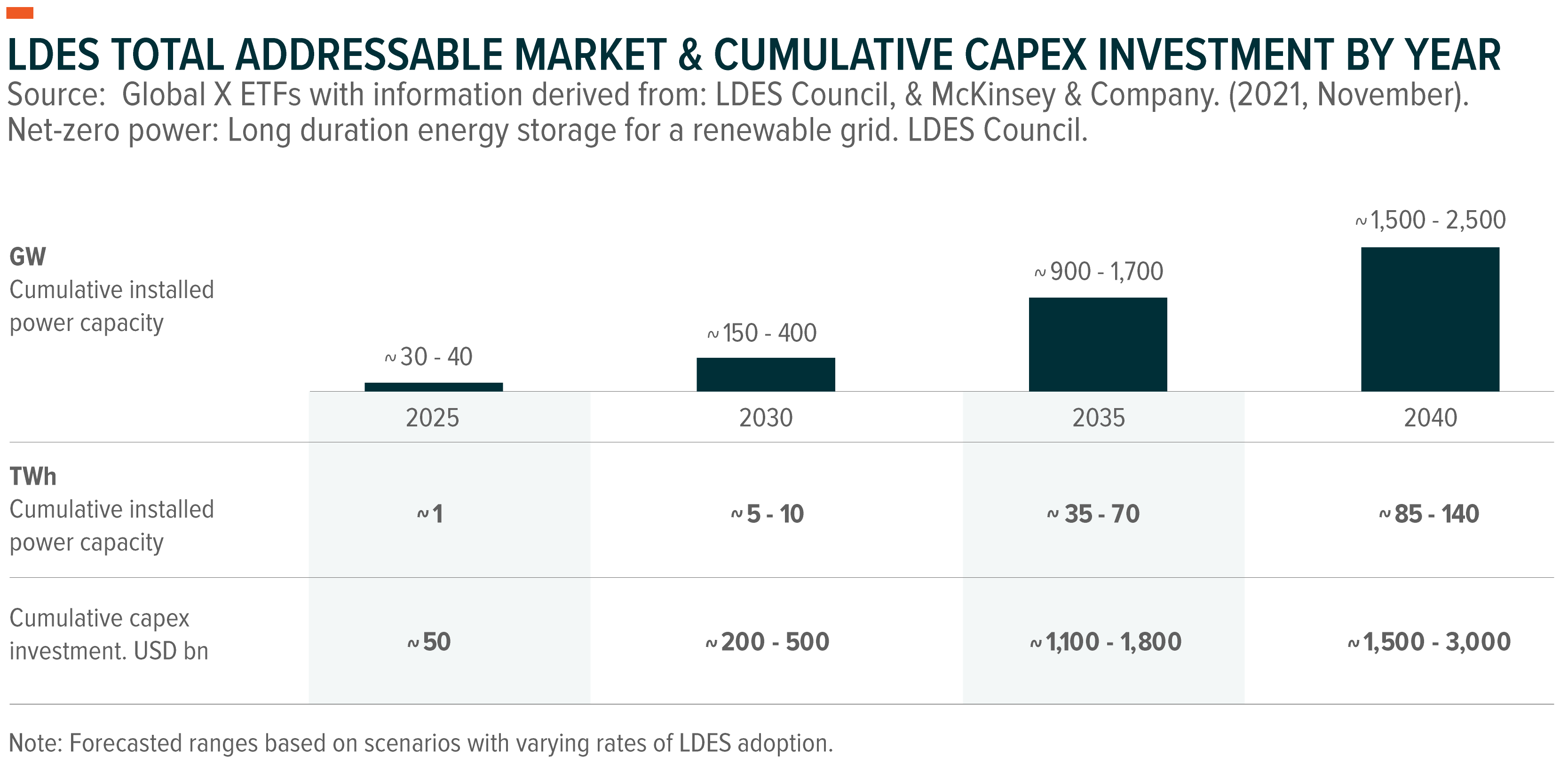
We expect that growth in LDES systems can also create investment opportunities in renewable energy. Similar to BESS, LDES systems could help unlock the potential of wind and solar power in power generation, particularly as renewables begin to reach 60–70% market share.45 Further grid stabilization could make renewables a more suitable option that compares to traditional stable baseload power sources such as natural gas, coal, and nuclear.
In addition, the need for LDES systems presents a sizeable use case for hydrogen, particularly green hydrogen. As the table below shows, hydrogen-based energy storage has the potential to store power for weeks to months, so these projects could be used to account for seasonal differences in electricity production.46 Power-to-hydrogen-to-power industrial-scale projects are still in the very early stages of development. That said, pilot projects are expected to come online over the next few years, including the 12MW HYFLEXPOWER project in France.47
Similar to hydrogen-based storage, most other LDES technologies are also in the early stages of adoption. The types of LDES systems that we expect to take off at a commercial scale include compressed air energy storage, liquid air energy storage, non-lithium-ion batteries, and hydrogen-based energy storage systems. The adoption of these technologies is expected to vary due to location suitability and cost constraints.
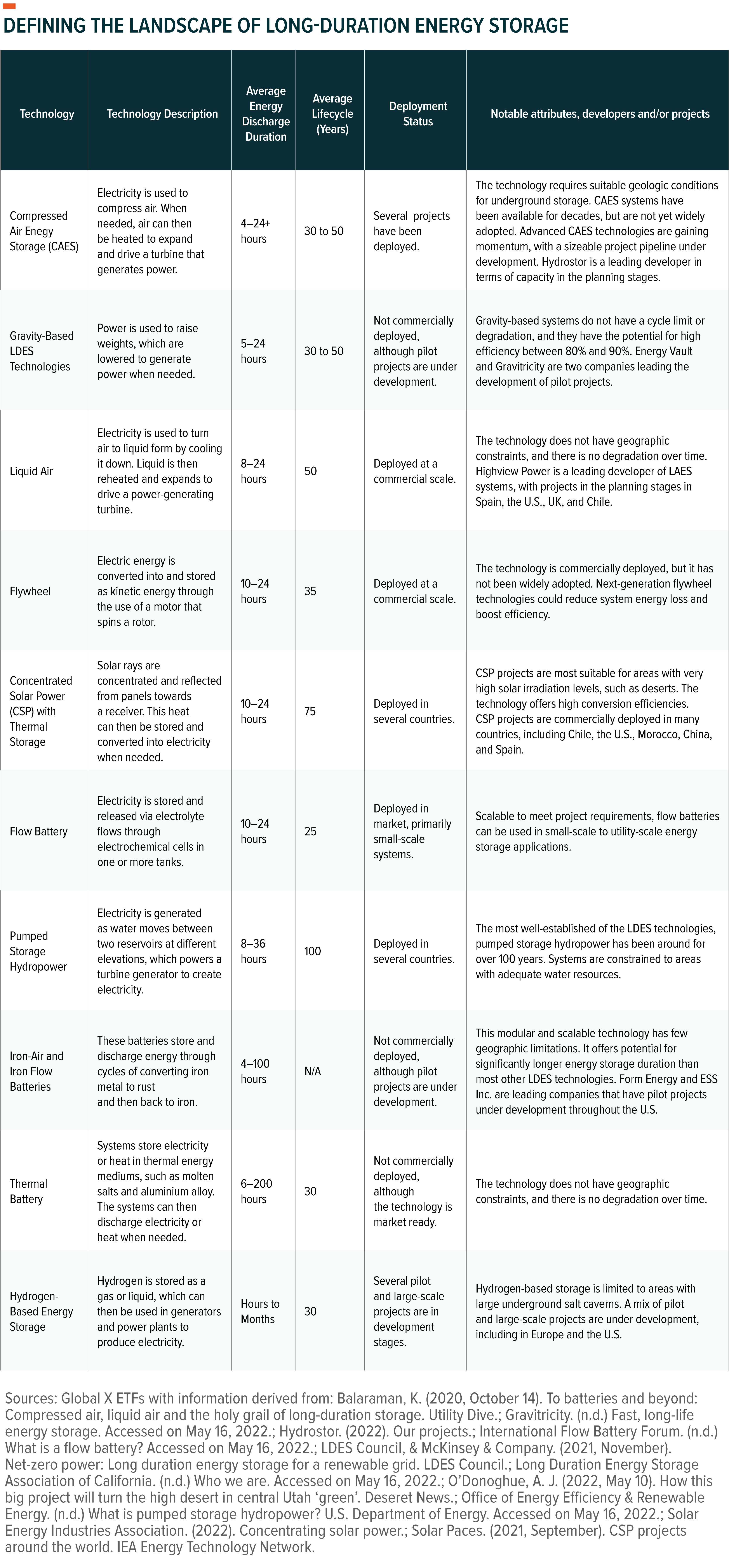
Conclusion: Energy Storage Plus Renewables Creates Opportunities
Renewable energy sources, primarily wind, and solar power, are set to account for the majority of growth within the power sector over the coming years. But to take full advantage of this potential growth requires reliable energy storage systems that can bolster energy grids already under pressure from increasing variability and climate change. We expect investment opportunities to materialize across the renewables and battery energy storage value chains, including miners of critical minerals, manufacturers of BESS technologies, and renewables developers. Longer-term, we expect the potential that long-duration energy storage systems hold to finally gain traction, accelerating opportunities in the renewables, energy storage, and hydrogen spaces.
Related ETFs
CTEC: The Global X CleanTech ETF seeks to invest in companies that stand to benefit from the increased adoption of technologies that inhibit or reduce negative environmental impacts. This includes companies involved in renewable energy production, energy storage, smart grid implementation, residential/commercial energy efficiency, and/or the production and provision of pollution-reducing products and solutions.
RNRG: The Global X Renewable Energy Producers ETF seeks to invest in companies that produce energy from renewable sources including wind, solar, hydroelectric, geothermal, and biofuels.
WNDY: The Global X Wind Energy ETF seeks to invest in companies positioned to benefit from the advancement of the global wind energy industry. This includes companies involved in wind energy technology production; the integration of wind into energy systems; and the development/manufacturing of turbines that harness energy from wind and convert it into electrical power.
RAYS: The Global X Solar ETF seeks to invest in companies positioned to benefit from the advancement of the global solar technology industry. This includes companies involved in solar power production; the integration of solar into energy systems; and the development/manufacturing of solar-powered generators, engines, batteries, and other technologies related to the utilization of solar as an energy source.
LIT: The Global X Lithium & Battery Tech ETF (LIT) invests in the full lithium cycle, from mining and refining the metal, through battery production.
DMAT: The Global X Disruptive Materials ETF seeks to invest in companies producing metals and other raw materials that are essential to the expansion of disruptive technologies, such as lithium batteries, solar panels, wind turbines, fuel cells, robotics, and 3D printers. Targeted materials include companies involved in the exploration, mining, production, and/or enhancement of Rare Earth Materials, Zinc, Palladium & Platinum, Nickel, Manganese, Lithium, Graphene & Graphite, Copper, Cobalt & Carbon Fiber.
HYDR: The Global X Hydrogen ETF (HYDR) seeks to invest in companies that stand to benefit from the advancement of the global hydrogen industry. This includes companies involved in hydrogen production; the integration of hydrogen into energy systems; and the development/manufacturing of hydrogen fuel cells, electrolyzers, and other technologies related to the utilization of hydrogen as an energy source.
Click the fund name above to view current holdings. Holdings are subject to change. Current and future holdings are subject to risk.
Footnotes
1. International Energy Agency (IEA). (2021, December 1). Renewable electricity growth is accelerating faster than ever worldwide, supporting the emergence of the new global energy economy [Press release]. https://www.iea.org/news/renewable-electricity-growth-is-accelerating-faster-than-ever-worldwide-supporting-the-emergence-of-the-new-global-energy-economy
2. International Energy Agency (IEA). (2021, December 1). Renewables 2021: Analysis and forecast to 2026. https://www.iea.org/reports/renewables-2021
3. Bettoli, A., Linder, M., Nauclér, T., Noffsinger, J., Sengupta, S., Tai, H & Gendt, G, V. (2021, November 22). Net-zero power: Long-duration energy storage for a renewable grid. McKinsey Sustainability. https://www.mckinsey.com/business-functions/sustainability/our-insights/net-zero-power-long-duration-energy-storage-for-a-renewable-grid
4. International Renewable Energy Agency (IRENA). (2022, April 11). Renewable capacity highlights. https://irena.org/-/media/Files/IRENA/Agency/Publication/2022/Apr/IRENA_-RE_Capacity_Highlights_2022.pdf?la=en&hash=6122BF5666A36BECD5AAA2050B011ECE255B3BC7
5. Ibid.
6. International Energy Agency (IEA). (2021, December 1). Renewables 2021: Analysis and forecast to 2026. https://www.iea.org/reports/renewables-2021
7. Ibid.
8. Ibid.
9. White House. (2021, April 22). Briefing room: Factsheet: President Biden sets 2030 greenhouse gas pollution reduction target aimed at creating good-paying union jobs and securing U.S. leadership on clean energy technologies [Press release]. https://www.whitehouse.gov/briefing-room/statements-releases/2021/04/22/fact-sheet-president-biden-sets-2030-greenhouse-gas-pollution-reduction-target-aimed-at-creating-good-paying-union-jobs-and-securing-u-s-leadership-on-clean-energy-technologies/
10. Bloomberg NEF. (2022, January 31). Blog: Corporate clean energy buying tops 30GW mark in a record year. https://about.bnef.com/blog/corporate-clean-energy-buying-tops-30gw-mark-in-record-year/
11. Ibid.
12. Renewable Energy World. (2021, November 16). Storage: Global energy storage market is set to grow 20X by 2030; will hit 1 TWh. https://www.renewableenergyworld.com/storage/global-energy-storage-market-set-to-grow-20x-by-2030-will-hit-one-terawatt-hour/#gref
13. Bloomberg NEF. (2021, November 15). Blog: Global energy storage market set to hit one terawatt-hour by 2030. https://about.bnef.com/blog/global-energy-storage-market-set-to-hit-one-terawatt-hour-by-2030/
14. Renewable Energy World. (2021, November 16). Storage: Global energy storage market is set to grow 20X by 2030; will hit 1 TWh. https://www.renewableenergyworld.com/storage/global-energy-storage-market-set-to-grow-20x-by-2030-will-hit-one-terawatt-hour/#gref
15. Guerra, O, J. (2021). Energy storage: Beyond short-duration energy storage. Nature Energy, 6(5), 460-461. https://doi.org/10.1038/s41560-021-00837-2
16. Congressional Research Service (CRS). (2019, June 25). Variable renewable energy: An introduction. In Focus. https://crsreports.congress.gov/product/pdf/IF/IF11257
17. Birol, F. (2021, July 15). Energy: 7 steps to make electricity systems more resilient to climate risks. World Economic Forum. https://www.weforum.org/agenda/2021/07/climate-change-electricity-energy-security-extreme-weather/
18. Ibid.
19. Staff. (2021, March 17). Reshaping the future of the electric grid through low-cost, long-duration discharge batteries. Argonne National Laboratory. https://www.anl.gov/article/reshaping-the-future-of-the-electric-grid-through-lowcost-longduration-discharge-batteries
20. Independent Statistics & Analysis. (2021, August). Battery storage in the United States: An update on market trends. U.S. Energy Information Administration (EIA). https://www.eia.gov/analysis/studies/electricity/batterystorage/pdf/battery_storage_2021.pdf
21. Ibid.
22. Standaert, M. (2021, December 1). Energy storage: China ramping up ambitious goals for industrial battery storage. Energy Monitor. https://www.energymonitor.ai/tech/energy-storage/china-ramping-up-ambitious-goals-for-industrial-battery-storage
23. Proctor, D. (2021, November 15). Distributed energy: Group forecasts a massive increase in energy storage by 2030. Power. https://www.powermag.com/group-forecasts-massive-increase-in-energy-storage-by-2030/
24. Fortune Business Insights. (2022, April 4). Battery energy storage market size [2021-2029] is worth USD 31.20 billion | exhibiting a CAGR of 16.3%. Globe Newswire. https://www.globenewswire.com/news-release/2022/04/04/2415710/0/en/Battery-Energy-Storage-Market-Size-2021-2029-worth-USD-31-20-Billion-exhibiting-a-CAGR-of-16-3.html
25. Hering, G., & Duquiatan, A. (2021, December 21). S&P Global market intelligence: US energy storage developers plan 9 GW in 2022, building on the 2021 breakthrough. S&P Global, Inc. https://www.spglobal.com/marketintelligence/en/news-insights/latest-news-headlines/us-energy-storage-developers-plan-9-gw-in-2022-building-on-2021-breakthrough-68012433
26. Cox, D. (2022, January 11). Solar: 10 notable battery storage projects that went live in 2021. Renewable Energy World. https://www.renewableenergyworld.com/solar/10-notable-battery-storage-projects-that-went-live-in-2021/#gref
27. Vistra. (2022, January 26). Environmental resources: Vistra announces the expansion of the world’s largest battery energy storage facility. CSRwire. https://www.csrwire.com/press_releases/735366-vistra-announces-expansion-worlds-largest-battery-energy-storage-facility
28. Thomas, S. (2020, December 15). The ESA blog: Storage as a transmission asset is gaining traction in many RTOs/ISOs. Energy Storage Association (ESA). https://energystorage.org/storage-as-a-transmission-alternative-is-gaining-traction-in-many-rtos-isos
29. Ibid.
30. Smith, F, M. (2018, January 23). Intro to energy storage. ClearPath. https://clearpath.org/tech-101/intro-to-energy-storage
31. Iaconangelo, D. (2022, May 17). Energy wire: U.S. renewable industry sees ‘unnecessary barriers’ ahead. Environment & Energy Publishing News Organization (E&E News). https://www.eenews.net/articles/u-s-renewable-industry-sees-unnecessary-barriers-ahead/
32. Azzopardi, T. (2021, October 11). Chile seeks developers for the power lines needed for renewables expansion. WindPower Monthly. https://www.windpowermonthly.com/article/1729901/chile-seeks-developer-power-line-needed-renewables-expansion
33. U.S. Energy Information Administration (EIA). (2021, September 29). Most planned U.S. battery storage additions in the next three years are to be paired with solar. https://www.eia.gov/todayinenergy/detail.php?id=49756
34. Sherman, L. (2021, November 4). Blogs: The next frontier of electric power will maximize renewable energy and storage. Renewable Energy World. https://www.renewableenergyworld.com/solar/the-next-frontier-of-electric-power-will-maximize-renewable-energy-and-storage/#gref
35. Fluence Energy, Inc. (2022, February 10). 1Q FY 2022 earnings presentation [PowerPoint slides]. https://ir.fluenceenergy.com/static-files/feff5db8-bc52-4429-83b5-dc0fc26e777f
36. Colthorpe, A. (2022, April 28). Tesla: Energy storage demand ‘remains significantly above’ production capacity. Energy Storage News. https://www.energy-storage.news/tesla-energy-storage-demand-remains-significantly-above-production-capacity/
37. Fluence Energy, Inc. (2022, February 10). 1Q FY 2022 earnings presentation [PowerPoint slides]. https://ir.fluenceenergy.com/static-files/feff5db8-bc52-4429-83b5-dc0fc26e777f
38. International Energy Agency (IEA). (2022, March). The role of critical minerals in clean energy transitions. https://www.iea.org/reports/the-role-of-critical-minerals-in-clean-energy-transitions/mineral-requirements-for-clean-energy-transitions
39. Guerra, O, J. (2021). Energy storage: Beyond short-duration energy storage. Nature Energy, 6(5), 460-461. https://doi.org/10.1038/s41560-021-00837-2
40. LDES Council. (2021 November). Net-zero power Long-duration energy storage for a renewable grid. Mckinsey & Company. https://www.mckinsey.com/~/media/mckinsey/business%20functions/sustainability/our%20insights/net%20zero%20power%20long%20duration%20energy%20storage%20for%20a%20renewable%20grid/net-zero-power-long-duration-energy-storage-for-a-renewable-grid.pdf
41. Plautz, J. (2021, November 23). Dive Brief: Long-duration energy storage should scale up 400x by 2040, bp, Siemens and ESS-backed group says. Utility Dive. https://www.utilitydive.com/news/long-duration-energy-storage-should-scale-up-400x-by-2040-bp-siemens-and/610472/
42. Bettoli, A., Linder, M., Nauclér, T., Noffsinger, J., Sengupta, S., Tai, H & Gendt, G, V. (2021, November 22). Mckinsey Sustainability, Our Insights: Net-zero power: Long-duration energy storage for a renewable grid. McKinsey. https://www.mckinsey.com/business-functions/sustainability/our-insights/net-zero-power-long-duration-energy-storage-for-a-renewable-grid
43. Ibid.
44. Plautz, J. (2021, November 23). Dive Brief: Long-duration energy storage should scale up 400x by 2040, bp, Siemens and ESS-backed group says. Utility Dive. https://www.utilitydive.com/news/long-duration-energy-storage-should-scale-up-400x-by-2040-bp-siemens-and/610472/
45. Ibid.
46. Balaraman, K. (2020, October 12). Deep dive: To batteries and beyond: With seasonal storage potential, hydrogen offers ‘a different ballgame entirely’. Utility Dive. https://www.utilitydive.com/news/to-batteries-and-beyond-with-seasonal-storage-potential-hydrogen-offers/584959/
47. Siemens energy global GMBH & Co. kg. (2022, April 27). Hydrogen is flexible energy storage for a fully renewable European power system. Cordis. https://cordis.europa.eu/project/id/884229
Investing involves risk, including the possible loss of principal. The companies in which CTEC, RNRG, WNDY, RAYS, LIT, and HYDR invest may be subject to rapid changes in technology, intense competition, rapid obsolescence of products and services, loss of intellectual property protections, evolving industry standards and frequent new product productions, and changes in business cycles and government regulation. The value of securities issued by companies in the energy sector may decline for many reasons, including, without limitation, changes in energy prices; international politics; energy conservation; the success of exploration projects; natural disasters or other catastrophes; changes in exchange rates, interest rates, or economic conditions; changes in demand for energy products and services; and tax and other government regulatory policies or contracts. Seasonal weather conditions may cause fluctuations in the performance of wind energy companies. Hydrogen, CleanTech, and renewable energy companies typically face intense competition, short product lifecycles and potentially rapid product obsolescence. They may be significantly affected by fluctuations in energy prices and in the supply and demand of renewable energy, tax incentives, subsidies and other governmental regulations and policies. There are additional risks associated with investing in mining industries. Investments in smaller companies typically exhibit higher volatility. International investments may involve risk of capital loss from unfavorable fluctuation in currency values, from differences in generally accepted accounting principles, or from economic or political instability in other nations. Emerging markets involve heightened risks related to the same factors as well as increased volatility and lower trading volume. CTEC, RNRG, WNDY, RAYS, LIT, DMAT and HYDR are non-diversified.
This information contains a manager’s opinion, is not intended to be individual or personalized investment or tax advice and should not be used for trading purposes.
Shares of ETFs are bought and sold at market price (not NAV) and are not individually redeemed from the Fund. Brokerage commissions will reduce returns.
Carefully consider the funds’ investment objectives, risks, and charges and expenses. This and other information can be found in the fund’s full or summary prospectuses, which may be obtained at globalxetfs.com. Please read the prospectus carefully before investing.
Global X Management Company LLC serves as an advisor to Global X Funds. The Funds are distributed by SEI Investments Distribution Co. (SIDCO), which is not affiliated with Global X Management Company LLC or Mirae Asset Global Investments. Global X Funds are not sponsored, endorsed, issued, sold or promoted by Solactive AG or Indxx, nor does Solactive AG or Indxx make any representations regarding the advisability of investing in the Global X Funds. Neither SIDCO, Global X nor Mirae Asset Global Investments are affiliated with Solactive AG or Indxx.
Disclaimer: Investing involves risk, including the possible loss of principal. International investments may involve risk of capital loss from unfavorable fluctuation in currency values, from ...
more


